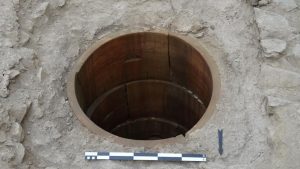ATHENS, GREECE – Archaeologists have uncovered what they believe to be the first Oracle ever built to the Greek god Apollo.
When we think about oracles to Apollo, what usually comes to mind is Delphi, that building atop that hill, where the Pythia would sit on her tripod in the caves under Delphi and give her very unspecific prophecies. Seekers would often have to crawl through the narrow, dark caverns, to what they believed was an entrance to the underworld to hear her speak.
Well, Archaeologists found yet another place where it’s believed the gods spoke through humans. This time, it’s a well in Athens.
The excavators were led by Dr. Jutta Stroszeck, director of the Kerameikos excavation on behalf of the German Archaeological Institute at Athens. Kerameikos is right in the center of Athens, just northwest of the Acropolis. The site has been under archaeological excavation since the 19th century when Archaeologists uncovered a marble omphalos. Ompholae are sacred stones, often called “belly-buttons of the world”, that are believed to be the stone that Zeus hurled to the Earth. In 2012, archaeologists discovered that the omphalos was, in fact, a covering for an opening. They decided to dig deeper. The omphalos was lifted by a crane. Under it, the researchers found a well.
Through the area flows the Eridanos river, that flows from east to west. The Athenias built wells along the river. Most of them were for public use, but some of them were not. The Athenians believed that water was sacred, and that it was protected by mischievous nymphs who could get upset if the water was mistreated. So, the Athenians would construct sacred oracular wells to appease these figures in their mythology. The well found at Kerameikos is one such well.
It’s walled with clay cylanders, and has over twenty inscriptions in ancient Greek.
“Come to me, O Paean, and bring with you the true oracle” – Greek inscription on the oracle well at Athens
“Paean” is one of the epithets of Apollo, and so, it could be inferred that the well was dedicated to the god associated with the arts, the muses, and prophecy.
Kerameikos was an important hub of activity in Athens. Its main street connected the agora (the main marketplace) of Athens with Plato’s Academy. It included the Athenian potters quarter, and an ancient cemetery. The whole area is a picture frozen in time of the transitions going on in Athens, connecting the city of the living to the city of the dead. Kerameikos was considered an area of high spiritual activity, a center for cultic activity in ancient Athens.
The sanctuary where the oracle to Apollo was found was inside a sanctuary dedicated to both Apollo, and his twin sister Artemis. The well was probably used for what we now call “hydromancy”, a method of divination by means of water. The well would have been a popular place to go before making any major decision, whether it was about simple everyday matters, a request for healing after falling ill, and the sanctuary itself was a place where criminals and fugitives could apply for sanctuary with the gods.
We best remember Athens as a hub for some of the best philosophy and scientific thought of the ancient world. Greats like Socrates and Plato came from Athens and added their voices to the discourse in the agora. But it’s archaeological sites like Kerameikos that paint a truer, fuller picture of the city. Kerameikos was not only a social and spiritual hub for the city, but its main street connected to Plato’s Academy, drawing yet another connection between two worlds. Religion and scientific thought were inextricably entwined in the ancient world, and Kerameikos is proof of that.



